使用 IDEA和Maven 整合SSH框架
1.创建web工程

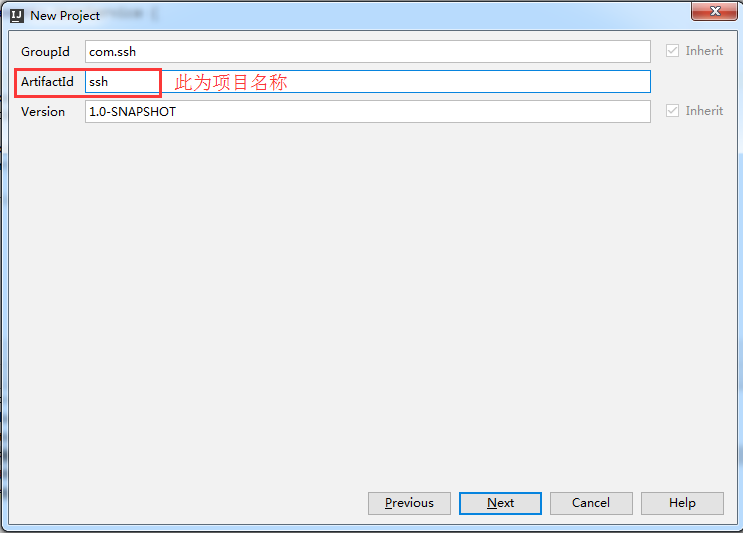
一路next 下去就行。完成后,IDEA会自动构建maven工程。
2.创建如下项目结构
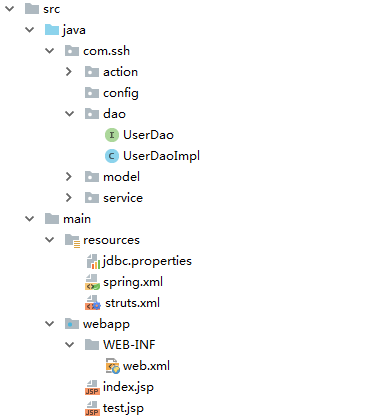
需要将 java文件夹设置为SourcesRoot目录,否则无法创建package
设置操作如下:选择文件夹,右击。
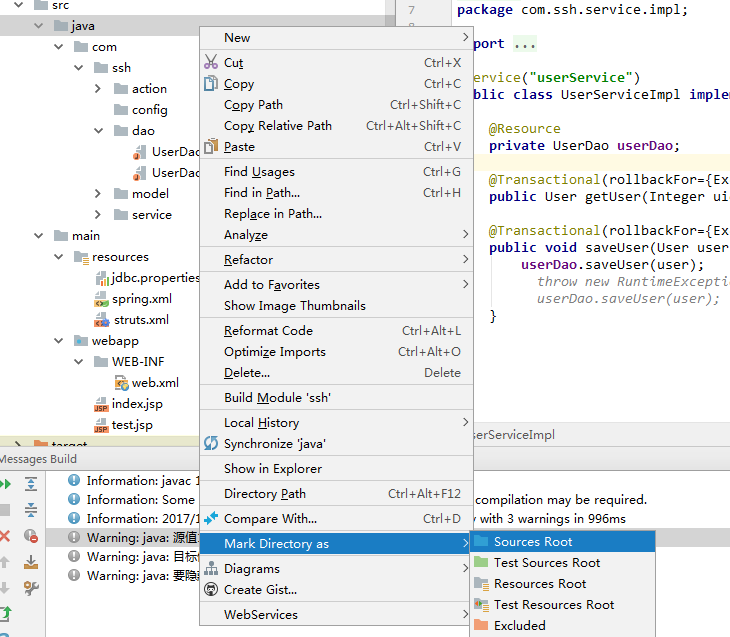
3.在pom.xml文件中引入框架包
<project xmlns="http://maven.apache.org/POM/4.0.0" xmlns:xsi="http://www.w3.org/2001/XMLSchema-instance"
xsi:schemaLocation="http://maven.apache.org/POM/4.0.0 http://maven.apache.org/maven-v4_0_0.xsd">
<modelVersion>4.0.0</modelVersion>
<groupId>com.ssh</groupId>
<artifactId>ssh</artifactId>
<packaging>war</packaging>
<version>1.0-SNAPSHOT</version>
<name>ssh Maven Webapp</name>
<url>http://maven.apache.org</url>
<dependencies>
<dependency>
<groupId>junit</groupId>
<artifactId>junit</artifactId>
<version>3.8.1</version>
<scope>test</scope>
</dependency>
<!-- hibernate -->
<dependency>
<groupId>org.hibernate</groupId>
<artifactId>hibernate-core</artifactId>
<version>5.2.12.Final</version>
</dependency>
<!-- struts2 -->
<dependency>
<groupId>org.apache.struts</groupId>
<artifactId>struts2-core</artifactId>
<version>2.5.14.1</version>
</dependency>
<!-- struts2 spring 整合的核心包-->
<dependency>
<groupId>org.apache.struts</groupId>
<artifactId>struts2-spring-plugin</artifactId>
<version>2.5.14.1</version>
</dependency>
<!-- spring -->
<dependency>
<groupId>org.springframework</groupId>
<artifactId>spring-core</artifactId>
<version>5.0.2.RELEASE</version>
</dependency>
<dependency>
<groupId>org.springframework</groupId>
<artifactId>spring-context</artifactId>
<version>5.0.2.RELEASE</version>
</dependency>
<dependency>
<groupId>org.springframework</groupId>
<artifactId>spring-jdbc</artifactId>
<version>5.0.2.RELEASE</version>
</dependency>
<dependency>
<groupId>org.springframework</groupId>
<artifactId>spring-beans</artifactId>
<version>5.0.2.RELEASE</version>
</dependency>
<dependency>
<groupId>org.springframework</groupId>
<artifactId>spring-web</artifactId>
<version>5.0.2.RELEASE</version>
</dependency>
<dependency>
<groupId>org.springframework</groupId>
<artifactId>spring-expression</artifactId>
<version>5.0.2.RELEASE</version>
</dependency>
<dependency>
<groupId>org.springframework</groupId>
<artifactId>spring-orm</artifactId>
<version>5.0.2.RELEASE</version>
</dependency>
<dependency>
<groupId>cglib</groupId>
<artifactId>cglib-nodep</artifactId>
<version>2.1_3</version>
</dependency>
<!--spring aop包 注释方式使用事务管理 可以不引用-->
<dependency>
<groupId>aspectj</groupId>
<artifactId>aspectjrt</artifactId>
<version>1.5.0</version>
</dependency>
<dependency>
<groupId>aspectj</groupId>
<artifactId>aspectjweaver</artifactId>
<version>1.5.0</version>
</dependency>
<!-- 添加对数据库的支持 -->
<dependency>
<groupId>mysql</groupId>
<artifactId>mysql-connector-java</artifactId>
<version>5.0.5</version>
</dependency>
<!-- https://mvnrepository.com/artifact/c3p0/c3p0 -->
<dependency>
<groupId>c3p0</groupId>
<artifactId>c3p0</artifactId>
<version>0.9.1.2</version>
</dependency>
</dependencies>
<build>
<finalName>ssh</finalName>
</build>
</project>
4.配置web.xml文件
<!DOCTYPE web-app PUBLIC
"-//Sun Microsystems, Inc.//DTD Web Application 2.3//EN"
"http://java.sun.com/dtd/web-app_2_3.dtd" >
<web-app>
<display-name>ssh</display-name>
<context-param>
<param-name>contextConfigLocation</param-name>
<param-value>classpath:spring.xml</param-value>
</context-param>
<filter>
<filter-name>struts2</filter-name>
<filter-class>org.apache.struts2.dispatcher.filter.StrutsPrepareAndExecuteFilter</filter-class>
</filter>
<filter-mapping>
<filter-name>struts2</filter-name>
<url-pattern>/*</url-pattern>
</filter-mapping>
<listener>
<listener-class>org.springframework.web.context.ContextLoaderListener</listener-class>
</listener>
</web-app>
5.配置spring的核心配置文件spring.xml,配置文件中扫描,注入各个javaBean,并且管理了hibernate的数据源和事务
--- jdbc配置文件 jdbc.properties
mysql.driverClassName = com.mysql.jdbc.Driver mysql.url = jdbc:mysql://localhost:3306/test?useUnicode=true&characterEncoding=utf-8 mysql.username = root mysql.password = 密码
<?xml version="1.0" encoding="UTF-8"?>
<beans xmlns="http://www.springframework.org/schema/beans"
xmlns:xsi="http://www.w3.org/2001/XMLSchema-instance"
xmlns:context="http://www.springframework.org/schema/context"
xmlns:tx="http://www.springframework.org/schema/tx"
xmlns:aop="http://www.springframework.org/schema/aop"
xsi:schemaLocation="http://www.springframework.org/schema/beans
http://www.springframework.org/schema/beans/spring-beans.xsd
http://www.springframework.org/schema/context
http://www.springframework.org/schema/context/spring-context.xsd
http://www.springframework.org/schema/tx
http://www.springframework.org/schema/tx/spring-tx.xsd
http://www.springframework.org/schema/aop
">
<context:component-scan base-package="com.ssh.action"></context:component-scan>
<context:component-scan base-package="com.ssh.service"></context:component-scan>
<context:component-scan base-package="com.ssh.dao"></context:component-scan>
<bean id="propertyConfigurer"
class="org.springframework.beans.factory.config.PropertyPlaceholderConfigurer">
<property name="location" value="classpath:jdbc.properties"/>
</bean>
<!-- data connection setting -->
<bean id="dataSource" class="com.mchange.v2.c3p0.ComboPooledDataSource">
<property name="driverClass" value="${mysql.driverClassName}"></property>
<property name="jdbcUrl" value="${mysql.url}"></property>
<property name="user" value="${mysql.username}"></property>
<property name="password" value="${mysql.password}"></property>
<!-- 设置数据库连接池的最大连接数 -->
<property name="maxPoolSize">
<value>50</value>
</property>
<!-- 设置数据库连接池的最小连接数 -->
<property name="minPoolSize">
<value>5</value>
</property>
<!-- 设置数据库连接池的初始化连接数 -->
<property name="initialPoolSize">
<value>5</value>
</property>
<!-- 设置数据库连接池的连接最大空闲时间 -->
<property name="maxIdleTime">
<value>20</value>
</property>
<!-- c3p0缓存Statement的数量数 -->
<property name="maxStatements">
<value>50</value>
</property>
<!-- 当连接池里面的连接用完的时候,C3P0一下获取新的连接数 -->
<property name="acquireIncrement">
<value>20</value>
</property>
</bean>
<!-- hibernate 管理-->
<bean id="sessionFactory" class="org.springframework.orm.hibernate5.LocalSessionFactoryBean">
<!-- 引用上面设置的数据源 -->
<property name="dataSource">
<ref bean="dataSource"/>
</property>
<property name="hibernateProperties">
<props>
<prop key="hibernate.dialect">org.hibernate.dialect.MySQLDialect</prop>
<prop key="hibernate.autoReconnect">true</prop>
<prop key="hibernate.connection.autocommit">true</prop>
<prop key="hibernate.hbm2ddl.auto">update</prop>
<prop key="hibernate.show_sql">true</prop>
<prop key="hibernate.format_sql">true</prop>
<!-- 解决session关闭问题 -->
<prop key="hibernate.enable_lazy_load_no_trans">true</prop>
<!-- spring 和 hibernate 整合的时候默认就是使用线程的,下面这一行不用写,写了反而要报错,此外 sessionFaction,不能使用openSession
既不能保存数据到数据库,还不能实现事务功能
-->
<!--<prop key="current_session_context_class">thread</prop>-->
<prop key="hibernate.max_fetch_depth">3</prop>
<prop key="hibernate.connection.url" >jdbc:mysql://localhost:3306/test</prop>
<prop key="hibernate.connection.driver_class">com.mysql.jdbc.Driver</prop>
</props>
</property>
<!-- 包扫描的方式加载注解类 -->
<property name="packagesToScan">
<list>
<value>com.ssh.model</value>
</list>
</property>
<property name="mappingLocations">
<list>
<value>classpath:com/ssh/model/User.hbm.xml</value>
</list>
</property>
</bean>
<!-- 用注解来实现事物管理 -->
<bean id="txManager" class="org.springframework.orm.hibernate5.HibernateTransactionManager">
<property name="sessionFactory" ref="sessionFactory"/>
</bean>
<tx:annotation-driven transaction-manager="txManager"/>
<!--<tx:advice id="txAdvice" transaction-manager="txManager">-->
<!--<tx:attributes>-->
<!--<tx:method name="*" read-only="false"/>-->
<!--</tx:attributes>-->
<!--</tx:advice>-->
<!--<aop:config>-->
<!--<aop:pointcut id="pt" expression="execution(* com.ssh.service.impl.*.*(..))"/>-->
<!--<aop:advisor advice-ref="txAdvice" pointcut-ref="pt"/>-->
<!--</aop:config>-->
</beans>
6.配置struts2的核心配置文件struts.xml
<?xml version="1.0" encoding="UTF-8"?>
<!DOCTYPE struts PUBLIC
"-//Apache Software Foundation//DTD Struts Configuration 2.5//EN"
"http://struts.apache.org/dtds/struts-2.5.dtd">
<struts>
<!-- 修改常量管理struts 中的action的工程,这个常量的使用,必须引入 spring和struts的整合包,不然spring无法管理struts2 Action 中的实体类-->
<constant name="struts.objectFactory" value="spring" />
<package name="user" extends="struts-default" namespace="/">
<action name="user_*" class="userAction" method="{1}">
<result name="success">/test.jsp</result>
<allowed-methods>m1,saveUser</allowed-methods><!-- struts 2.5 之后,使用通配符必须加上这一行 ,否则无法使用通配符访问-->
</action>
</package>
</struts>
7.使用IDEA生成数据库对应实体类和hibernate的映射文件
第一步:连接数据库
选择后边侧边栏的Database
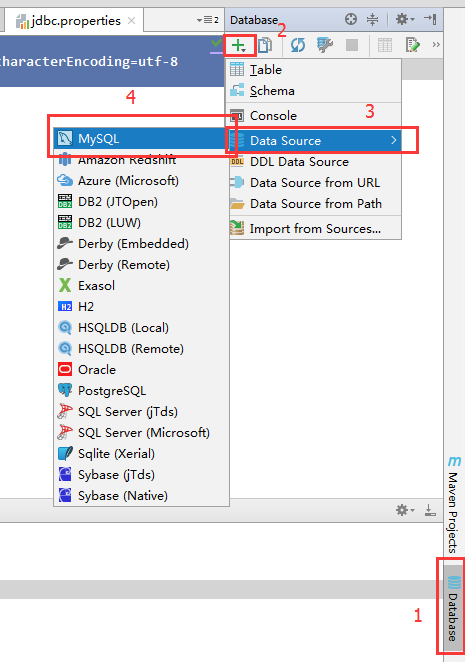
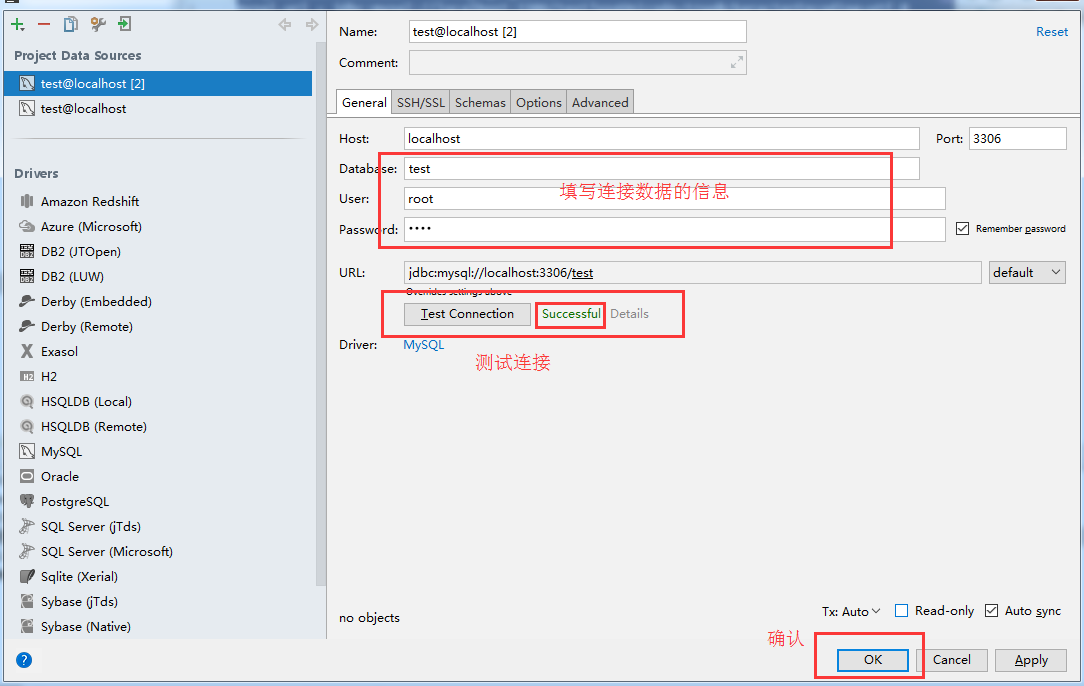
第二步,生成映射文件
选中左边侧边栏的Persistence菜单

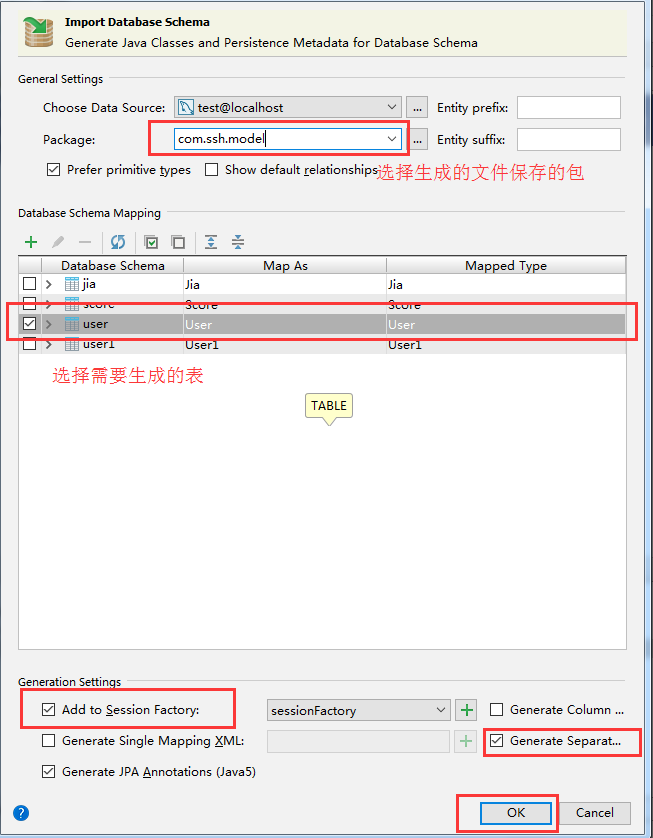
等待生成映射文件,完成后,在对应的包 下面生成如下文件

USer 代码
/**
* FileName: User
* Author: GET_CHEN
* Date: 2017/12/13 13:45
* Description:
*/
package com.ssh.model;
import javax.persistence.Basic;
import javax.persistence.Column;
import javax.persistence.Entity;
import javax.persistence.Id;
@Entity
public class User {
private int uid;
private String uname;
@Id
@Column(name = "uid")
public int getUid() {
return uid;
}
public void setUid(int uid) {
this.uid = uid;
}
@Basic
@Column(name = "uname")
public String getUname() {
return uname;
}
public void setUname(String uname) {
this.uname = uname;
}
@Override
public boolean equals(Object o) {
if (this == o) return true;
if (o == null || getClass() != o.getClass()) return false;
User user = (User) o;
if (uid != user.uid) return false;
if (uname != null ? !uname.equals(user.uname) : user.uname != null) return false;
return true;
}
@Override
public int hashCode() {
int result = uid;
result = 31 * result + (uname != null ? uname.hashCode() : 0);
return result;
}
}
USer.hbm.xml文件内容如下:
<?xml version='1.0' encoding='utf-8'?>
<!DOCTYPE hibernate-mapping PUBLIC
"-//Hibernate/Hibernate Mapping DTD 3.0//EN"
"http://www.hibernate.org/dtd/hibernate-mapping-3.0.dtd">
<hibernate-mapping>
<class name="com.ssh.model.User" table="user" schema="test">
<id name="uid" column="uid"/>
<property name="uname" column="uname"/>
</class>
</hibernate-mapping>
8.完成mvc的架构中,各个部分的代码。
-- dao 层

接口UserDao代码
/**
* FileName: UserDao
* Author: GET_CHEN
* Date: 2017/12/13 11:34
* Description:
*/
package com.ssh.dao;
import com.ssh.model.User;
public interface UserDao {
User getUser(Integer uid);
void saveUser(User user);
}
实现类UserDaoImpl的代码
/**
* FileName: UserDaoImpl
* Author: GET_CHEN
* Date: 2017/12/13 11:57
* Description:
*/
package com.ssh.dao;
import com.ssh.model.User;
import org.hibernate.Session;
import org.hibernate.SessionFactory;
import org.hibernate.Transaction;
import org.springframework.stereotype.Repository;
import org.springframework.transaction.annotation.Transactional;
import javax.annotation.Resource;
@Repository("userDao")
public class UserDaoImpl implements UserDao {
@Resource(name="sessionFactory")
private SessionFactory sessionFactory;
public User getUser(Integer uid) {
Session session = sessionFactory.getCurrentSession();
//当getCurrentSession所在的方法,或者调用该方法的方法绑定了事务之后,session就与当前线程绑定了,也就能通过currentSession来获取,否则就不能。
User user = session.get(User.class, uid);
// session.close();
return user;
}
public void saveUser(User user) {
Session session = sessionFactory.getCurrentSession();
session.save(user);
System.out.println("======="+user.getUname());
//使用getCurrentSession后,hibernate 自己维护session的关闭,写了反而会报错
}
}
-- service层

接口UserService的代码
/**
* FileName: UserService
* Author: GET_CHEN
* Date: 2017/12/13 11:31
* Description:
*/
package com.ssh.service;
import com.ssh.model.User;
public interface UserService {
User getUser(Integer uid);
void saveUser(User user);
}
实现类UserServiceImpl的代码
/**
* FileName: UserServiceImpl
* Author: GET_CHEN
* Date: 2017/12/13 11:32
* Description:
*/
package com.ssh.service.impl;
import com.ssh.dao.UserDao;
import com.ssh.model.User;
import com.ssh.service.UserService;
import org.springframework.stereotype.Service;
import org.springframework.transaction.annotation.Transactional;
import javax.annotation.Resource;
@Service("userService")
public class UserServiceImpl implements UserService {
//依赖Dao
@Resource
private UserDao userDao;
// 注入事务管理
@Transactional(rollbackFor={Exception.class, RuntimeException.class})
public User getUser(Integer uid) {
return userDao.getUser(uid);
}
@Transactional(rollbackFor={Exception.class, RuntimeException.class})
public void saveUser(User user) {
userDao.saveUser(user);
// throw new RuntimeException();
// userDao.saveUser(user);
}
}
-- 控制层 Action

UserAction代码如下
/**
* FileName: TestAction
* Author: GET_CHEN
* Date: 2017/12/13 9:52
* Description:
*/
package com.ssh.action;
import com.opensymphony.xwork2.ActionSupport;
import com.ssh.model.User;
import com.ssh.service.UserService;
import org.springframework.context.annotation.Scope;
import org.springframework.stereotype.Controller;
import javax.annotation.Resource;
@Controller("userAction")
@Scope("prototype")
public class UserAction extends ActionSupport{
//定义存放到值栈中的对象
private User user;
//依赖service
@Resource
private UserService userService;
//实现要存放到值栈中对象的get方法
public User getUser() {
return user;
}
public String m1(){
user = userService.getUser(1);
System.out.println(user.getUname());
return SUCCESS;
}
public String saveUser(){
User user = new User();
user.setUname("事务提交");
userService.saveUser(user);
return SUCCESS;
}
}
-- view层test.jsp页面的代码
<%--
Created by IntelliJ IDEA.
User: GET_CHEN
Date: 2017/12/13
Time: 13:57
To change this template use File | Settings | File Templates.
--%>
<%@ page contentType="text/html;charset=UTF-8" language="java" %>
<%-- 引入struts2 的标签库--%>
<%@ taglib prefix="s" uri="/struts-tags" %>
<html>
<head>
<title>ssh测试</title>
</head>
<body>
<%-- 获取值栈中的user对象的uname的值--%>
用户名: <s:property value="user.uname"></s:property>
</body>
</html>
9.部署项目到Tomcat
-- 配置Tomcat

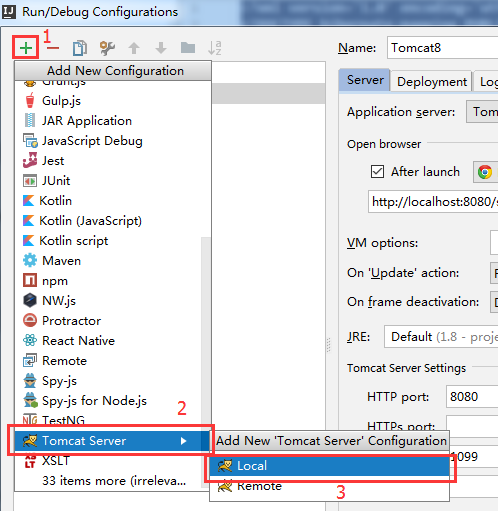
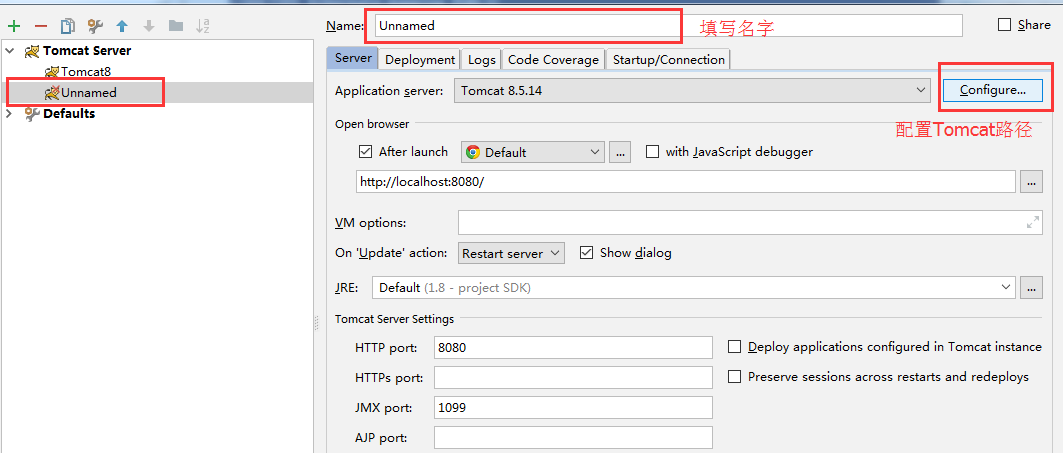
选择上图中的Configure进入,配置tomcat路径
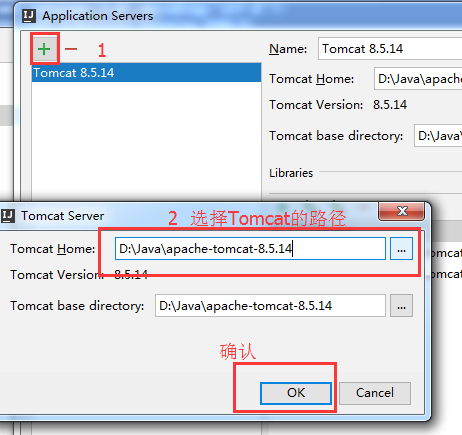
确认后,回到上级页面,选择Deployment菜单项,添加工程到Tomcat
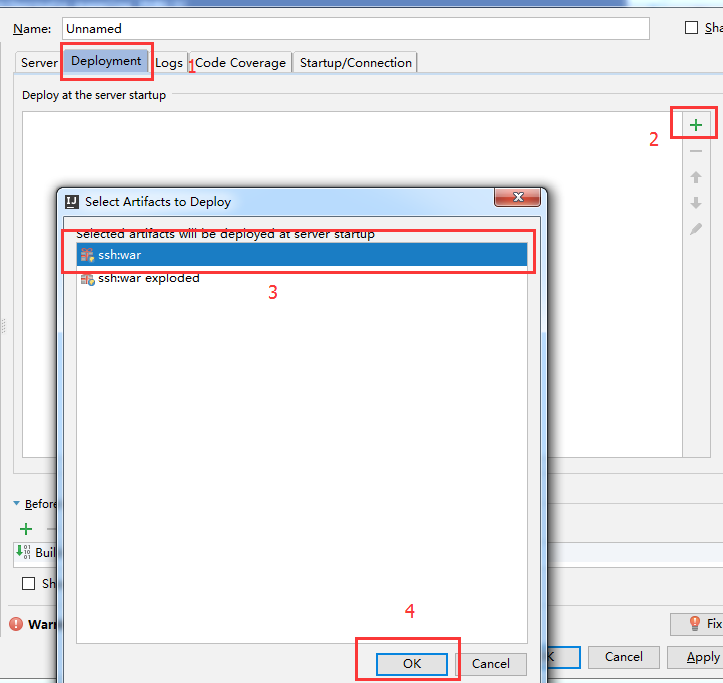
10.启动Tomcat,访问Action中的方法
-- 切换到Tomcat,点击绿色按钮启动Tomcat

-- 在地址栏输入,如下地址。结果如下。
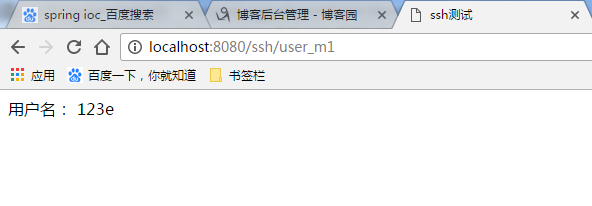
------------------ 今天分享到处
------------------By GET_CHEN




